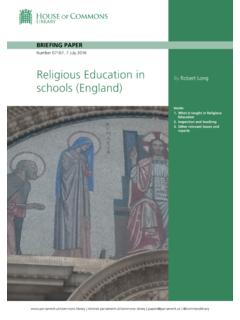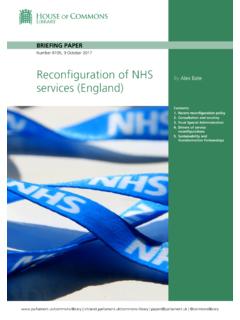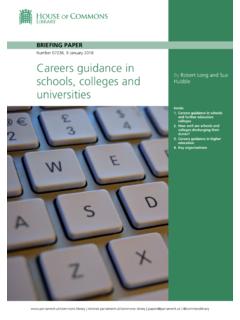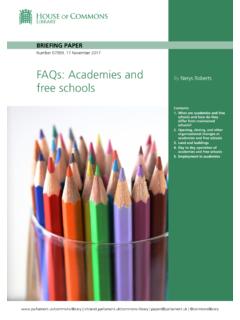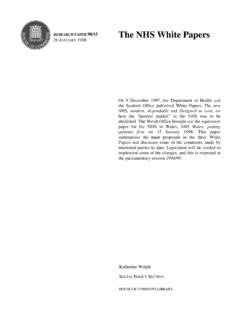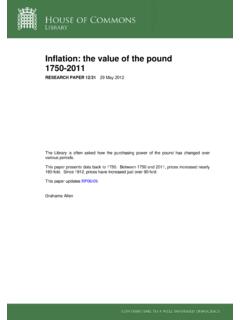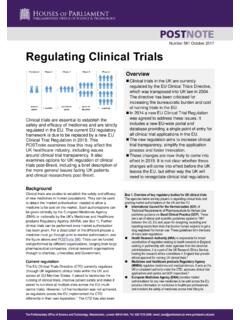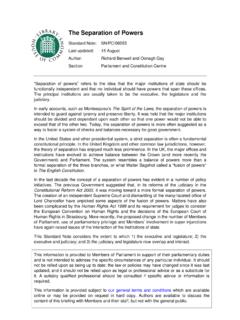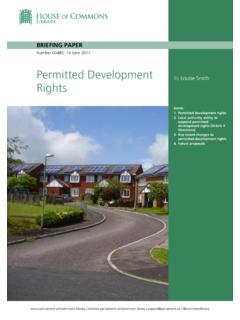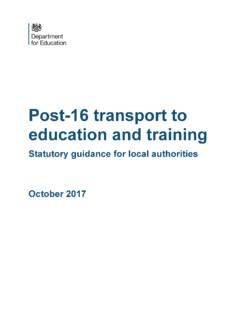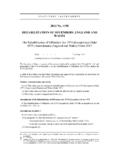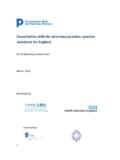Transcription of Education: Historical statistics
1 Standard Notes are compiled for the benefit of Members of Parliament and their personal staff. Authors are available to discuss the contents of these papers with Members and their staff but cannot advise others. education : Historical statistics Standard Note: SN/SG/4252 Last updated: 27 November 2012 Author: Paul Bolton Social & General statistics The organisation of every stage of education has undergone significant change over the last century. These changes have fundamentally altered most aspects of education . Historical indicators are therefore particularly interesting, but also problematic. Very few series are consistent over more than a few decades. The definition/size of different stages of education (primary, secondary, further/higher), school leaving ages and examinations have changed markedly as have state organisation and funding.
2 As key concepts in education change so do the types of statistics collected. The increased role of the state in the first half of the 20th century also widened the scope of official education statistics . This note presents a small number of long-term education indicators. Most start in the early 20th century and all have a number of breaks. While these make interpretation of trends more difficult, the breaks themselves highlight the changes in the sector. Where possible UK figures are given, however with different departments being responsible for education in england and Wales and Scotland and latterly all four home countries, this is not possible for many series. Northern Ireland figures are included in UK data from the early 1920s onwards. Contents A. List of Tables and charts 2 B.
3 Changes in education in the 20th century 3 C. Snapshots of education c1900-2010 3 D. Schools 5 1. Elementary/primary education 5 2. Secondary education 6 a. Types of secondary schools 7 3. Independent schools 8 4. Staying on /enrolment rates 9 E. Examinations 10 F. Further education 13 G. Higher education 13 H. Reference tables 15 2 A. List of Tables and charts ChartsAverage size of public elementary/primary schools in the UK5 Pupil:teacher ratio in elementary/primary schools in the UK6 Average size of a public 'secondary' schools in the UK7 Pupil:teacher ratios in public 'secondary' schools in the UK8 Pupils at state secondary schools, by type, england and Wales9 Proportion of pupils at independent and direct grant grammar schools in england and Wales10 Pupils in full-time education beyong the leaving age11 Achievement of O Levels/GCSEs13A level achievement at schools and colleges13 Learners at further education and adult education institutions14 Students obtaining university degrees in the UK -thousands15 Reference TablesTable 1 Public sector elementary/primary schools in the UK16 Table 2 Public sector 'secondary' schools in the UK17 Table 3 Public secondary schools by type.
4 england and Wales17 Table 4 Independent schools in england and Wales18 Table 5 Enrolment and post-compulsory staying-on rates, UK19 Table 6 Examination results, england and Wales20 Table 7 Learners at further education institutions, england and Wales20 Table 8 Students obtaining university degrees, UK21 3 B. Changes in education in the 20th century The most important factors as far as the statistical series go were The minimum school leaving age increased from 12 to 14 in 1918, to 15 in 1947 and 16 in 1972. The education Act 1902 which replaced School Boards with local education authorities and gave them a duty of maintaining voluntary (church) schools. The education Act 1918 which ended what fees that remained in public elementary schools and set up approved university examining bodies.
5 education Act 1944 which extended free education to all state secondary schools and introduced the tripartite system (grammar, technical and modern) to secondary education . It also introduced a common national distinction between primary and secondary education at 11. The 1965 circular 10/65 which encouraged local education authorities to move to non-selective secondary education . The introduction of the General Certificate of education (GCE) examination in 1951 and the General Certificate of Secondary education (GCSE) in 1988. 1992 reorganisation of the higher education sector which brought former polytechnics into the university sector. C. Snapshots of education c1900-2010 Below are a range of statistics from the beginning and middle of the 20th and start of the 21st centuries:1 c1900 In 1900 there were 34,300 elementary schools/departments inspected by the relevant bodies in england , Wales and Scotland.
6 On average they had 154 pupils each and aggregate attendance was million pupils. There was an average of 42 pupils per teacher (of varying qualification levels). There were 969 grant-aided secondary schools in england , Wales and Scotland in 1909 attended by 172,000 pupils. Their average size was 179 pupils and there was an average of 16 pupils per teacher. In 1900-01 the average salary of a certified teacher in england and Wales was 128 for a man and 86 for a woman. Uprated for inflation these salaries would be worth around 10,500 and 7,100 in 2005 prices respectively. of central government revenue was spent on education in 1900-01. In 1910-11 there were 639,000 students who attended grant-aided establishments of further education (mainly evening classes/institutions) in england and Wales.
7 In 1919 28,800 pupils were entered for one or more school certificate examinations in england and Wales. In 1920 3,200 were entered for one or more Higher School Certificate Examinations. In 1922-23 9,200 students were awarded first degrees and 1,600 were awarded higher degrees. 1 While these include data from later in this note, they also include others figures that were only produced as one offs in the earlier years - education 1900-1950 The report of the Ministry of education and the statistics of public education for england and Wales for the year 1950. B R Mitchell British Historical statistics chapter XV; statistics of education 1975, and earlier editions, Department of education and Science. Statistical abstract for the United Kingdom 1938, and earlier years, Board of Trade.
8 education and training statistics for the UK 2006, and earlier editions, DfES. Public expenditure statistical analysis 2006, HM Treasury. House of Commons Library Research Paper 06/09 Inflation: The value of the pound 1750-2005. 4 In 1913 of the 14-16 year old population in england and Wales were in full-time education in grant aided schools/colleges. c1950 In 1951 there were 27,700 public primary schools or departments in the UK. These were attended by million pupils, there was an average of 171 pupils in each school and an average of 30 pupils per teacher. In 1951 there were 5,900 public secondary schools in the UK. These were attended by million pupils; there was an average of 342 pupils in each school and an average of pupils per teacher.
9 Of central government revenue was spend on education in 1949-50 In 1949-50 there were million students who attended grant-aided establishments of further education (again mainly evening and part-time courses) in england and Wales. In 1953-54 of the relevant age group passed five or more GCE O levels at schools in england and Wales. of the relevant age group passed one or more GCE A level and public sector schools and further education establishments. In 1950 17,300 students were awarded first degrees and 2,400 were awarded higher degrees at UK universities. In 1950 30% of 15 year olds, 14% of 16 year olds and 7% of 17 year olds were in full-time education in england and Wales. c2010 In 2010-11 there were 21,281 public sector mainstream primary schools.
10 These were attended by million pupils, there was an average of 231 pupils in each school and an average of pupils per teacher. In 2010-11 there were 4,072 public sector mainstream secondary schools. These were attended by million pupils; there was an average of 943 pupils in each school and an average of pupils per teacher. The average salary of full-time qualified teachers in public sector schools in england was 34,700 in November 2011. Expenditure on education made up of total public sector expenditure in 2010-11. In 2010/11 there were million learners who started a publicly funded further education course in the UK. In 2010/11 of pupils in their last year of compulsory education in the UK achieved 5 or more GCSE grades A*-C or equivalent.
